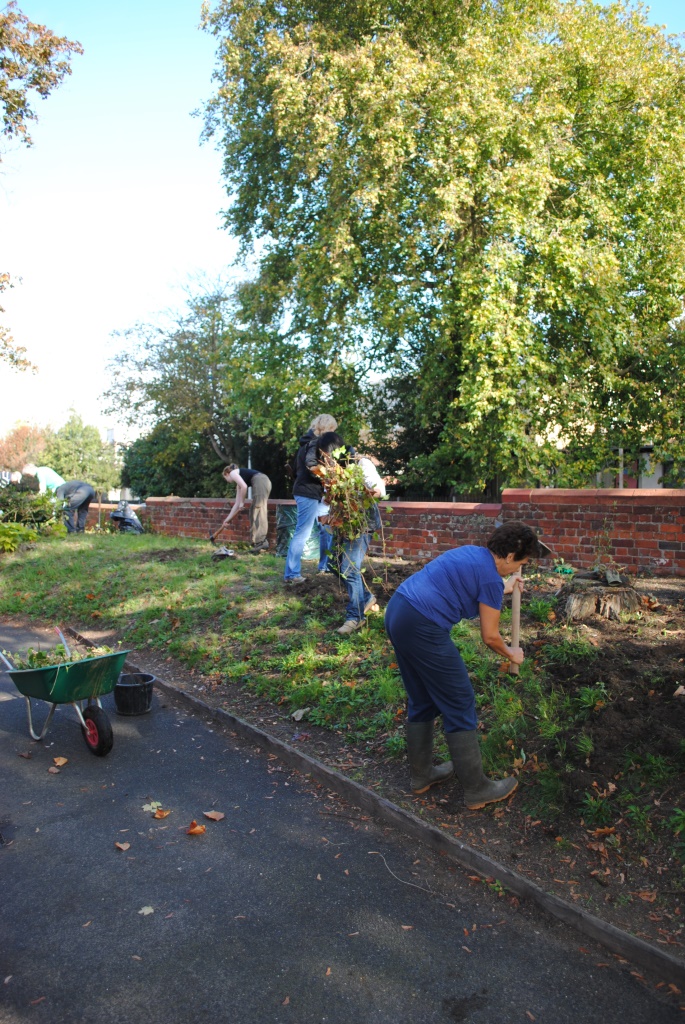In this month’s Volunteers’ Voice, Volunteer Co-ordinator Rob Davies gives some background on some gardening at MERL and enlists the help of our two of our gardening volunteers to explain how they have helped create bee-friendly habitats in the MERL gardens…
We have an outstanding volunteer gardening team who come, rain or shine, to tend to our gardens. We have a series of plots which have a different theme every year. In the past we have had a war-time garden, white borders and a myriad of tulips.
Our volunteer garden team also have worked on the National Lottery Project ‘A Green Welcome’ which has transformed our dull uninviting front garden into a welcoming and wildlife friendly space. We worked with The Conservation Volunteers (TCV) on this project, they are an inspirational organisation who work with volunteers on sites across Reading. I certainly learnt a lot from them, in particular how to make hurdle!
This year we opted for plants that encourage bees. With the national decline in the bee population, we have themed our plots not only to attract and support bees but also to encourage visitors to the museum to do the same.
Below, two of gardening volunteers, Tony and Roger have described the work they have done but also talk about the Bee World project which is being coordinated by the Friends of the Earth.
The “Bee World” is an idea that is being promoted by Friends of the Earth. According to their website, Bee Worlds are havens of wildflowers in urban and rural spaces. They provide essential food and shelter for bees, and help reverse the trend of declining bee populations in the UK. To find out more about Bee Worlds, you can download a Bee World Information Pack from the Friends of the Earth website, or borrow a copy to use during your visit to MERL.
Our Bee Project at MERL has been set up to show you what you can do in your own garden to help bees – whether by leaving a part of your garden to nature’s care, or by growing a variety of flowers and vegetables that provide food for bees. Remember, bees are like people, they need somewhere to live, and regular meals.
Here are some of the things we have done to help bees in the MERL garden:
- Half-hardy annuals. After the first of three beds of roses, Bed 1 nearest to the main entrance to the gardens was used to grow flowering plants that were bought from White Tower Nursery at Aldermaston. These are mostly half-hardy annuals (raised under glass and planted out as soon as spring frosts are over) plus a few perennials. They all have one thing in common: they are attractive to bees of many species.
- Hardy annual mixtures. Bed 2 was divided into four sections and annual flower seed sown directly into the ground in early April. They were covered in permeable horticultural fleece to conserve moisture and maintain warmth in the early days of the spring. Four mixtures of annual flowers were grown: “Wildflower Honey Bee-friendly mixture”, “Butterfly mixture”, “Fragrant mixture” and “Fairy mixture”.Germination was excellent and by mid June many of the species in the four mixtures from Thompson and Morgan had begun to come into flower. The results were quite startling in the range of species, flower type and colour (we have still not identified many of them yet!). This wide range of species is a most important factor in supporting the population of various pollinating insects since the flowering period of so many species differs. The length of time that they were in flower was very satisfying and the later part of the summer weather was just what they needed. These beds in particular seemed to be alive with insect life for the whole summer. It is also a very inexpensive way of covering odd sunny corners of gardens with colour and interest. At the same time, they provide pollinating insects with a source of nectar and pollen during their most active period.
- Vegetables. We also grew runner beans, french beans and broad beans as examples of vegetables that bees pollinate. Difficult weather conditions this year meant that the early broad beans germinated badly in the wet part of the early summer and had to be sown again. The next sowing merely provided an excellent food source for black aphids as the hot weather tightened its grip. Detergent spray was used with a suitable level of outrage but ensured only cleaner-looking aphids. That’s horticulture!
You can see more pictures of the bee friendly beds at MERL on our Flickr page




